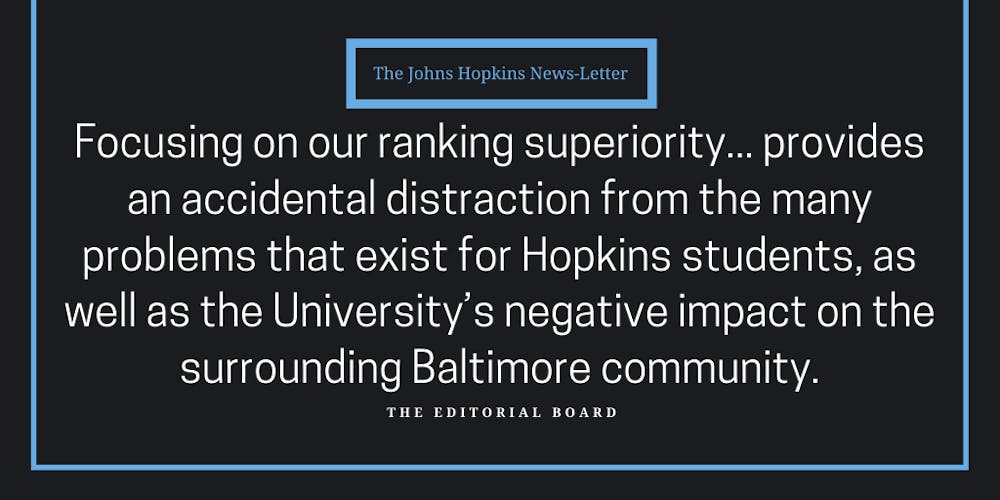Hopkins was named the nation’s ninth best university by U.S. News & World Report on Monday, moving up a spot from last year.
The announcement of this arbitrary ranking was met with quite the fanfare in the Hopkins community. The University’s social media pages celebrated the news. Students and alumni flooded our feeds, delighted about the University’s new status.
It’s perfectly understandable for students, staff, faculty and administrators to be proud of our new position. That number translates to a quantifiable measure of the University’s standing as an academic institution.
However, our big, shiny ranking does not totally encapsulate the University’s quality. Instead, it presents a rosy picture of Hopkins that is not entirely accurate.
U.S. News determines rankings based on factors such as graduation and retention rates, graduation performance rates, graduate indebtedness, perceived social mobility of attendees and student excellence. The ranking system also takes into account a school’s financial resources, faculty resources, alumni giving and expert opinion — how the administrators of other peer universities rate the school.
Yet, it is impossible for one number to take into account all of the aspects of the student experience at Hopkins. Focusing on our ranking superiority has the adverse effect of allowing the University to ignore its failings in other respects. It provides an accidental distraction from the many problems that exist for Hopkins students, as well as the University’s negative impact on the surrounding Baltimore community.
The University’s treatment of its staff and faculty falls short of its ranking.
Throughout the summer, professors were continually left in the dark about plans for our current fall semester. We worry that this lack of transparency will persist as the spring approaches.
This summer, Black staff and faculty fought for better representation on campus and improved treatment of the furloughed dining staff that allow the campus to run smoothly. But U.S. News does not consider how a university treats its employees or whether its commitment to racial equity extends beyond the surface.
Hopkins students at all levels have been undersupported by the University as well. Graduate students, whose teaching and research promotes the strength of our institution, were met with inadequate support and security during a pandemic. Meanwhile, students residing off-campus in Charles Village still lack sufficient access to University-provided testing for the coronavirus (COVID-19). The University’s status lies with its students, yet it fails to ensure our health.
Even in a world without COVID-19, Hopkins focuses on its prestige rather than its students. According to the University’s Second Commission of Undergraduate Experience (CUE2), student well-being and mental health doesn’t exactly fall in line with our number nine ranking. In fact, according to the February report, “our students report greater stress than those at other schools.” Our ranking suggests that Hopkins students are bright and well-accomplished; it masks the toxic environment that fuels our impossible pursuit of perfection.
Many students prioritize papers and problem sets over self-care and happiness. We lack school spirit, we have few traditions (before COVID-19, they were already getting shut down) and instead of fighting for tickets for on-campus events, we fight for an empty seat in the library.
Even within the classroom, the “student experience” doesn’t take priority. One component used to determine which school is “best” is its percentage of small classes. This is why certain courses are capped at 19 students, and the unlucky twentieth student is placed on an eternal waitlist.
Rather than arbitrarily limiting class sizes, the University should be evaluated according to a meaningful measure of professor engagement and accessibility. Student course evaluations would be a good metric to measure professor effectiveness. This metric could even benefit Hopkins — we are happy to praise many of our professors, who are dedicated to their fields and our education.
Unfortunately, the University’s focus on ranking does not surprise us. Hopkins has a history of prioritizing its image over the interests of its community. The past few months offer a prime example. Despite a nationwide reckoning with structural racism and police violence, Hopkins has yet to take meaningful action to address its history of exploiting Black residents of the city or its ongoing contributions to racial injustice.
Nevertheless, we acknowledge the improvements Hopkins made to get us to our coveted U.S. News ranking. These include securing research funds and expanding support and resources available to First-Generation, Low-Income students. These accomplishments are something to be proud of.
Still, we have to ask how well this ranking reflects the Hopkins experience. Universities should be assessed based on more meaningful, personal factors, like how they treat their students, staff and community members. If these factors don’t impact rankings, will institutions work to improve them?
Some of these issues are not unique to Hopkins, but appear universally in higher education. That does not mean we should ignore the problems; we must reckon with them before we celebrate our status. Hopkins should set an example, and perhaps our peer institutions will follow.





